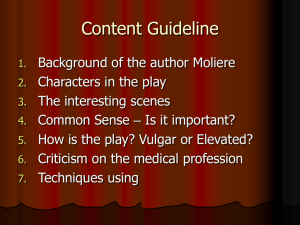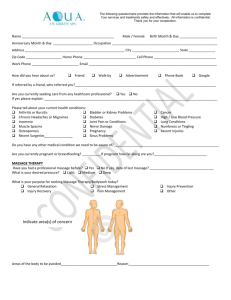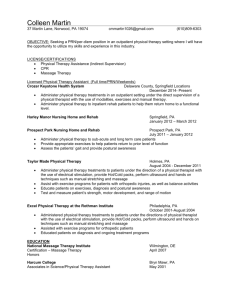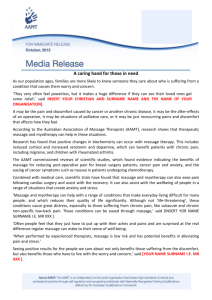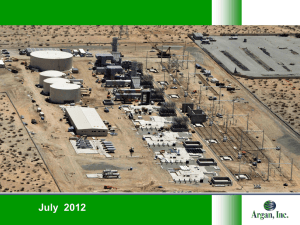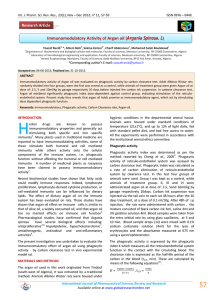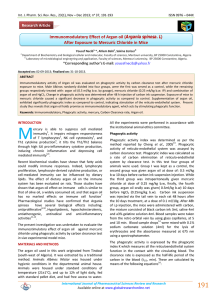Beauty Care in the Maghreb
advertisement
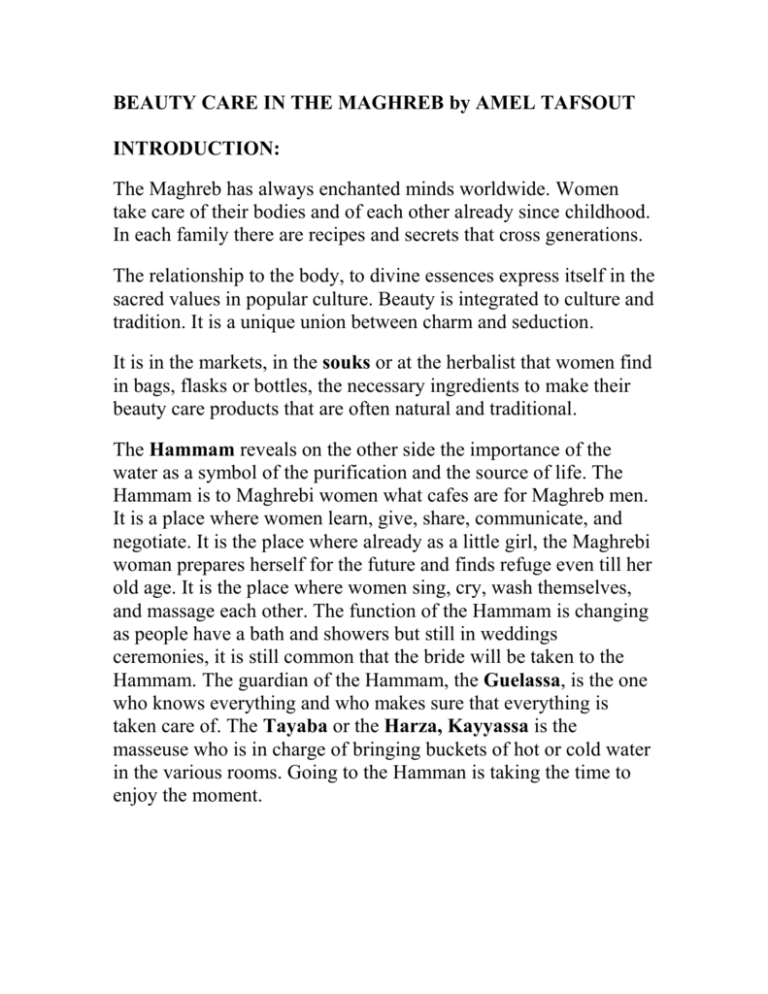
BEAUTY CARE IN THE MAGHREB by AMEL TAFSOUT INTRODUCTION: The Maghreb has always enchanted minds worldwide. Women take care of their bodies and of each other already since childhood. In each family there are recipes and secrets that cross generations. The relationship to the body, to divine essences express itself in the sacred values in popular culture. Beauty is integrated to culture and tradition. It is a unique union between charm and seduction. It is in the markets, in the souks or at the herbalist that women find in bags, flasks or bottles, the necessary ingredients to make their beauty care products that are often natural and traditional. The Hammam reveals on the other side the importance of the water as a symbol of the purification and the source of life. The Hammam is to Maghrebi women what cafes are for Maghreb men. It is a place where women learn, give, share, communicate, and negotiate. It is the place where already as a little girl, the Maghrebi woman prepares herself for the future and finds refuge even till her old age. It is the place where women sing, cry, wash themselves, and massage each other. The function of the Hammam is changing as people have a bath and showers but still in weddings ceremonies, it is still common that the bride will be taken to the Hammam. The guardian of the Hammam, the Guelassa, is the one who knows everything and who makes sure that everything is taken care of. The Tayaba or the Harza, Kayyassa is the masseuse who is in charge of bringing buckets of hot or cold water in the various rooms. Going to the Hamman is taking the time to enjoy the moment. Depilation or waxing: In the Arab world a woman needs to get rid of the hair in her body, so it is a real ritual to do the depilation. The day of her wedding, the Maghrebi woman has to get rid of all hair in her body. Women use ancient recipes such as sugar, gum, honey, and lemon. Often heated together make the base of the paste. One of the important part of the body are the feet, that is the reason why Maghrebi women will make sure to get rifd of the dead skin surrounding their heals. Massage: Etymologically speaking, massage comes from the Arab word mass, which means knead, massage and press. No wonder that massage has roots in the Maghreb (North Africa). Over there it is more than just a ritual: it’s an institution. Every week Arab men and women go to hammams (Turkish steam baths) to cleanse their bodies and minds and to relax. Etymologically speaking, massage comes from the Arab word mass, which means touch softly, massage and press. No wonder that massage has roots in the Maghreb (North Africa). Over there it is more than just a ritual: it’s an institution. Every week Arab men and women go to hammams (Turkish steam baths) to cleanse their bodies and minds and to relax. Origins The development of hammams and massage in the Maghreb is attributed to the prophet Mohammed and originated in the 7th century. After discovering steam baths and massage from his neighbours, the Greeks and the Romans, he was immediately taken by their purifying powers on the body and mind. He incorporated them into religious practice and encouraged the construction of hammams as extensions to mosques. Later on, in the 11th century, Avicenna, a prominent Iranian philosopher and physician, wrote about the benefits of massage, stressing that it was intended to "dispel harmful substances in muscles that are not eliminated by physical exercise." Practice All oriental massage is preceded by a session at the hammam that lasts for around 20 minutes. Steam baths take place in an enclosed space with simple refined Arab decor. Sometimes essential pine or eucalyptus oils are used. Steam baths are hot and humid, and this relaxes muscles, eliminates toxins, opens up pores and relaxes the whole body and mind. The hammam is an important part of the process as it helps to prepare you for the massage. After a few minutes of rest after the hammam, the massage begins. It is carried out on bare skin using hot argan oil. oriental massage is performed from the head to the feet, following the layout of the muscles. The session usually ends with a few minutes of relaxation and a refreshing cup of mint tea. Benefits - The techniques used in this massage help eliminate toxins and relax muscles, promoting overall wellbeing. - The argan oil used is very rich in essential fatty acids, Vitamin E and polyphenols. It enhances cell functions and nourishes the skin, leaving it soft and silky. - Antioxidants in mint tea drain toxins released during the massage and add to the regenerating effect! Maghrebi women use essential oils such as rose, eucaliptus, orang blossom, olive, bergamot are often used. INGREDIENTS: HENNA: Henna is a tall shrub or small treet. Usually, Arabic people and Muslims wear the 'Henna'. Somalians, Ethiopians and even Syrians wear the beautiful temporary tattoo. Henna has been used since the Bronze Age to dye skin (including body art), hair, fingernails, leather, silk and wool. In several parts of the world it is traditionally used in various festivals and celebrations. There is mention of henna as a hair dye in Indian court records around 400 CE,[8] in Rome during the Roman Empire, and in Spain during Convivencia.[9] It was listed in the medical texts of the Ebers Papyrus (16th-century BCE Egypt)[10] and by Ibn Qayyim al-Jawziyya (14th century CE (Syria and Egypt) as a medicinal herb.[11] In Morocco, wool is dyed and ornamented with henna, as are drumheads and other leather goods. Lawsone, an active compound in Henna. Use of henna for body art has enjoyed a recent renaissance due improvements in cultivation, processing, and the emigration of people from traditional henna-using regions. For skin dyeing, a paste of ground henna (either prepared from a dried powder or from fresh ground leaves) is placed in contact with the skin from a few hours to overnight. Henna stains can last a few days to a month depending on the quality of the paste, individual skin type, and how long the paste is allowed to stay on the skin. Henna also acts as an anti-fungal and a preservative for leather and cloth. Henna flowers have been used to create perfume since ancient times, and henna perfume is experiencing a resurgence. Henna repels some insect pests and mildew. Henna's coloring properties are due to lawsone, a burgundy organic compound that has an affinity for bonding with protein. Lawsone is primarily concentrated in the leaves, especially in the petioles of the leaf. Lawsone content in leaves is negatively correlated with the number of seeds in the fruits. GHASSOUL: The rhassoul or ghassoul is a natural mineral clay mined in the Atlas Mountains of Morocco since the eighth century. It is combined with water to clean the body and has been used by Moroccan women for centuries to care for their skin and hair. Rhassoul contains silicon, iron, magnesium, potassium, sodium, lithium, and trace elements. Today, rhassoul is used in Turkish baths. Along with a glove, or "kessa", Rhassoul is used as a facial mask and poultice to the body. It is similar to a western style mud wrap. It is intended to soften the skin, reduce sebum secretion, regenerate the skin by removing dead cells, and rebalance the skin by tightening the pores.[2] ARGAN OIL: Argan oil is a plant oil produced from the kernels of the argan tree (Argania spinosa L.), endemic to Morocco, that is valued for its nutritive, cosmetic and numerous medicinal properties. It is also known in cosmetic use as moroccan oil. Culinary uses Culinary argan oil (argan food oil) is used for dipping bread, on couscous, salads and similar uses. Amlou, a thick brown paste with a consistency similar to peanut butter, is produced by grinding roasted almond and argan oil using stones, mixed with honey and is used locally as a bread dip. Various claims about the beneficial effects on health due to the consumption of argan oil have been made. Researchers have concluded that daily consumption of argan oil is 'highly likely' to be one factor helping the prevention of various cancers, cardiovascular diseases and obesity.[11] The results of a nutritional intervention study, in which volunteers were given either argan oil or animal fats (butter) in their diet, were published in 2005. The results showed that regular dietary intake of argan oil led to reduced levels of harmful cholesterol and triglycerides in the blood, compared to a diet with regular intake of animal fats.[12] Cosmetic uses Unroasted argan oil is traditionally used as a treatment for skin diseases and as a cosmetic oil for skin and hair: "In cosmetics, argan oil is advocated as moisturizing oil, against juvenile acne and flaking of the skin as well as for nourishing the hair. This oil has also medicinal uses against rheumatism and the healing of burns ... Externally, argan oil is used ... for hair as brilliantine, to fortify and ... in the treatment of wrinkled or scaly dry skin". Argan oil has become increasingly popular for cosmetic use. The number of personal-care products on the US market with argan oil as an ingredient increased from just two in 2007 to over one hundred by 2011. It is sometimes mixed with pomegranate seed oil due to its antioxidizing benefits with vendors promoting this blend as an all-in-one serum both for skin and hair. Argan oil is also sold without additives as a natural skincare and hair care product. The increasing popularity of argan oil has prompted the Moroccan government to plan for increased production: its aim is to increase annual production from approximately 2,500 to 4,000 tonnes by 2020. KHOL , KAJAL SWAAK: For whitening the tees and used for cosmetic FACIAL HAIR BODY FEET WEDDINGS
